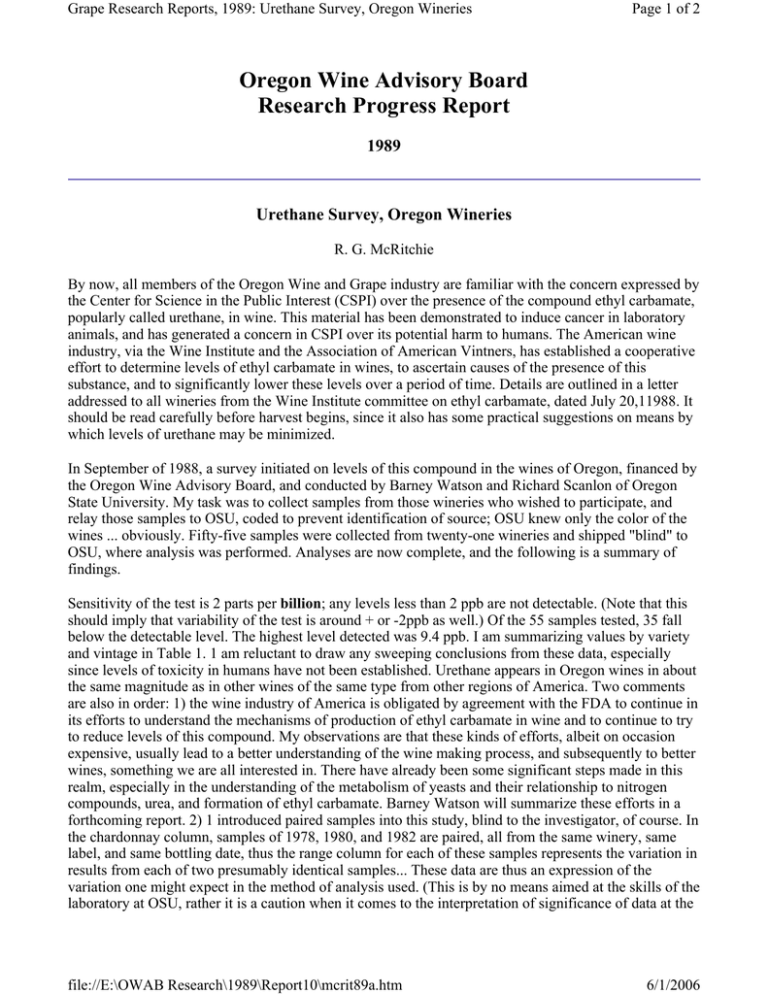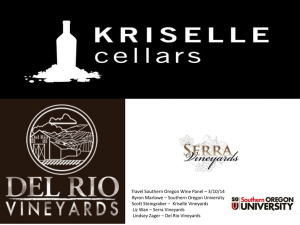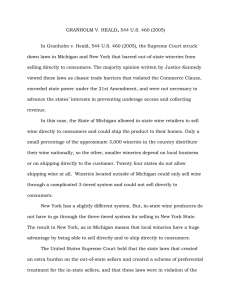Oregon Wine Advisory Board Research Progress Report 1989 Urethane Survey, Oregon Wineries
advertisement

Grape Research Reports, 1989: Urethane Survey, Oregon Wineries Page 1 of 2 Oregon Wine Advisory Board Research Progress Report 1989 Urethane Survey, Oregon Wineries R. G. McRitchie By now, all members of the Oregon Wine and Grape industry are familiar with the concern expressed by the Center for Science in the Public Interest (CSPI) over the presence of the compound ethyl carbamate, popularly called urethane, in wine. This material has been demonstrated to induce cancer in laboratory animals, and has generated a concern in CSPI over its potential harm to humans. The American wine industry, via the Wine Institute and the Association of American Vintners, has established a cooperative effort to determine levels of ethyl carbamate in wines, to ascertain causes of the presence of this substance, and to significantly lower these levels over a period of time. Details are outlined in a letter addressed to all wineries from the Wine Institute committee on ethyl carbamate, dated July 20,11988. It should be read carefully before harvest begins, since it also has some practical suggestions on means by which levels of urethane may be minimized. In September of 1988, a survey initiated on levels of this compound in the wines of Oregon, financed by the Oregon Wine Advisory Board, and conducted by Barney Watson and Richard Scanlon of Oregon State University. My task was to collect samples from those wineries who wished to participate, and relay those samples to OSU, coded to prevent identification of source; OSU knew only the color of the wines ... obviously. Fifty-five samples were collected from twenty-one wineries and shipped "blind" to OSU, where analysis was performed. Analyses are now complete, and the following is a summary of findings. Sensitivity of the test is 2 parts per billion; any levels less than 2 ppb are not detectable. (Note that this should imply that variability of the test is around + or -2ppb as well.) Of the 55 samples tested, 35 fall below the detectable level. The highest level detected was 9.4 ppb. I am summarizing values by variety and vintage in Table 1. 1 am reluctant to draw any sweeping conclusions from these data, especially since levels of toxicity in humans have not been established. Urethane appears in Oregon wines in about the same magnitude as in other wines of the same type from other regions of America. Two comments are also in order: 1) the wine industry of America is obligated by agreement with the FDA to continue in its efforts to understand the mechanisms of production of ethyl carbamate in wine and to continue to try to reduce levels of this compound. My observations are that these kinds of efforts, albeit on occasion expensive, usually lead to a better understanding of the wine making process, and subsequently to better wines, something we are all interested in. There have already been some significant steps made in this realm, especially in the understanding of the metabolism of yeasts and their relationship to nitrogen compounds, urea, and formation of ethyl carbamate. Barney Watson will summarize these efforts in a forthcoming report. 2) 1 introduced paired samples into this study, blind to the investigator, of course. In the chardonnay column, samples of 1978, 1980, and 1982 are paired, all from the same winery, same label, and same bottling date, thus the range column for each of these samples represents the variation in results from each of two presumably identical samples... These data are thus an expression of the variation one might expect in the method of analysis used. (This is by no means aimed at the skills of the laboratory at OSU, rather it is a caution when it comes to the interpretation of significance of data at the file://E:\OWAB Research\1989\Report10\mcrit89a.htm 6/1/2006 Grape Research Reports, 1989: Urethane Survey, Oregon Wineries Page 2 of 2 part per billion level.) I am sending the specific individual data to all participating wineries within the next few days. Should any questions arise, please feel free to contact me directly. file://E:\OWAB Research\1989\Report10\mcrit89a.htm 6/1/2006

